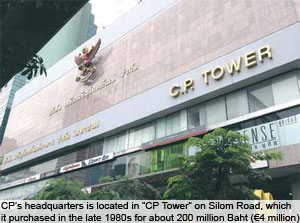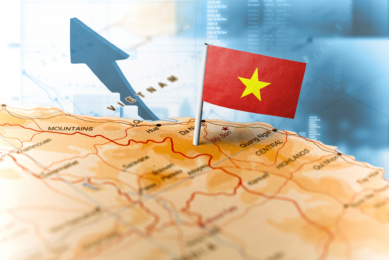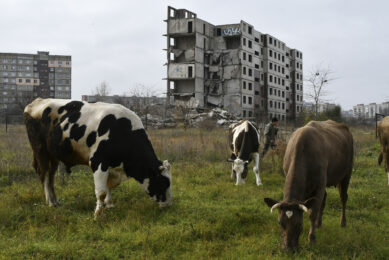Thailand is pivotal for agricultural growth in Southeast Asia

Asia is the one region that was least effected by the financial crisis and recovered more quickly than Europe and the United States.Thailand’s largest agriculture conglomerate Charoen Pokphand Foods was still able to write black figures on Q3, where others presenteda downturn in profits and turnover. Focusing on China is giving them another competitive edge. Reason enough to talk to two executive vice presidents of the CP group and discuss developments in Southeast Asia.
Charoen Pokphand Foods more than any other food producing company recognises the global environment in which they are operating.
Why the world’s changing prerogatives are forcing us to rethink our agricultural practices!
“It’s not what we can or can’t do, it’s the necessity of accepting the fact that we are now ‘one world’, as the narrowing divides that once separated us are in the process of disappearing. The future belongs to those of us who can accept this fact and proceed accordingly.” No where, is this truer, says Dr. Sarasin Viraphol, Executive Vice President of the CP Group, than in today’s livestock industry, where, like or not, we are now ‘without boundaries’ world food suppliers and the challenges and opportunities have never been greater.
Asia has recovered more quickly and in a much stronger position than Europe and America. “We in Thailand learned this from an earlier crisis in 1997 where we were terribly affected…and learned our lesson.
Today, Asia led by China, is now in the driver’s seat as far as everything, including ‘food for the world’ is concerned. “Asia is now leading the world in global growth and Thailand is very much a part of this.
In 1979, CP introduced agriculture development in China. With that strong foundation we are now in a position to take advantage of China’s focus on internal development which has now shifted to ‘international development’. China is the new big market for agro development and food.”
Internal development
More than 50% of the pork produced in the world is consumed in China and more than 50% of the pigs in the world today are raised in China, largely by small farmers. In the future, because this is all changing and China is learning very fast, the country is shifting from raising pigs in small households to industrial farming. This is why, following the 2008 financial crisis, the world is shifting attention to Asia, as the new engine of growth.
Why was Southeast Asia and Thailand in specific not so much affected by the financial crisis?
Sarasin: “Thailand learned from our own crisis in 1997, we were knocked out and were ‘out’ and because of that we were not caught in the middle of this storm, like the other countries; the US, the ‘biggest loser’ and Europe. And on the basis of this experience, Asia, including Thailand and China have learned that Asian economies, like Thailand have learned that exports as the main engine of economic growth, is no longer unattainable! What we have to do is turn inwards towards internal development. The future scenario for Asia is this internal development. That is much harder but in the long-run is much more rewarding. If Thailand is looking at foreign investments, like Africa, for more raw materials or more commodities, we are looking for technology and know-how for value-added feed additives for instance. This is the strength of CP, based on its own experience of developing agro business and we have done this in China, Indonesia, Vietnam, Malaysia, India, all developing countries and economies in Asia, which can be a lesson for the rest of the world – with normal feed livestock.”
Regarding investments, where should the focus be?
Sarasin: “Business, as CP has known it, is and has changed; the new focus is on branding and value-adding, targeting the differences in market groups. Globalisation has made everyone an equal player, offering various possibilities and opportunities, in which Thailand is a strong base from which to pursue its global business as manager of fast food enterprises, because it allowed CP more flexibility in financial management.”
“Today, what is important is not bank financing but linkage, where it can be established, with retailers. This gives us flexibility in financial management. As we have learned, this was a new way of thinking. Before assets were collateral, not anymore, what had become more important was cash-flow.”
But how to establish a healthy cash-flow?
Sarasin: “CP has made the transition, safely and with intelligent planning and forethought and has invested in a wide range of agro businesses – feed mills, livestock farms, aqua culture and further processing in Vietnam, Turkey, China, India, Indonesia, Laos, Malaysia, Pakistan, the Philippines and Russia.
“All of this could not have been contemplated if CP had not from the very beginning advocated a strong research and development program, placing a priority on finding ways to improve productivity along the whole chain of animal and food production. A good example, now definitely paying off, is the Feed Ingredients Unit set up in May 2008, to provide consortium-management services in sourcing raw materials in the 13 countries in which CP operates. Also research was put into plants and by-products with potential for use in alternative energy production including corn stalks, wheat stalks, switch grass, eucalyptus, miscanthus, wood, straw, bagasse and coffee-bean peel.”
Feed ingredients
The Thai animal feed market has continued to grow and expand throughout the years. In CP’s own experience, agricultural development in the emerging economies of countries like the Philippines and in Africa show considerable growth trends and their potential to expand limitless. The African region provides a great opportunity for agribusiness due to large arable lands and low transportation costs, thereby allowing for the low production cost of a value-added end-product. CP has set up a new business group to handle trading in feed ingredients as part of efforts to increase cost efficiency and improve management of raw materials in the present world food crisis.
The new group was formed in May 2008 to provide consortium-management services in sourcing raw materials in the 13 countries in which CP operates. After completely systematising the conglomerate’s data, it plans to boost the group’s competitiveness and bargaining power in raw-material trading. The move came after CP faced rising raw-material prices, while slowing consumption hit its food businesses and forced the group to cut production. “To cope with the cost-push factor, we must integrate information from all of our units, in order to increase operational efficiency and reduce management costs,” said Somchai Kungsamutr, president Trading Business Group. He said the dual problems of rising animal-feed prices and lower consumer purchasing power had forced many large companies that had to feed animals, including CP Foods, to reduce production capacity, in order to maintain business growth.
CP plans to reduce costs and risk management on fluctuating prices for food crops, which are easily affected by rising world demand and high oil prices. Under the new group’s operations, CP will closely monitor price movements for food crops in each market, as well as in future markets. It will set up purchasing spots in each market to supply CP’s different business units and distribute raw materials to factories in other countries.
It also plans to establish warehouses in 13 countries, starting with Cambodia, to ensure sufficient supplies of raw materials for the group’s production needs. Somchai said the new group was confident of linking up the conglomerate’s information concerning feed ingredients within a year, after which it might try to achieve other synergies.
Raw materials sourcing
At CP raw materials that consist of protein are mainly sourced from the USA, Brazil, Argentina and India. For carbohydrates, there are enough local products to source from and even export (for example: rice, rice bran, and broken-milled rice).
At the moment, the ‘Food Crisis/Fuel’ has taken over headlines when compared to the issue of GMO utilisation. The concern for food security has meant that a lot more people are open towards ways in which the country can increase food production and because of these issues, anti-GMO use has dwindled considerably. However, CP’s position is that it must be able to identify that all the commodities are sourced from non-GMO producers as indicated by the European Union standards.
Carbon footprint
Now that global warming has also become an issue CP is currently involved in two projects. Firstly there is the Thailand – European Union Project PAS 2050. In association with the Kasetsart University of Thailand, the Public Available Specification 2050 (PAS 2050) is an ongoing research study created to follow the standard ‘Carbon Footprint’ initiated by the EU for Thai products so that a general standard can be utilised. This project was established on August 2007 and will be completed by March 2010. The CP product involved in the PAS 2050 project is that of the ‘Chicken Snack’. The carbon footprint of the product is tracked and recorded to better understand product implications in the areas of global warming and how each footprint may be improved upon.”
The second project is the PGO Project of the Global Warming Organization. CP had issued ‘fresh chicken’, ‘chicken teriyaki’, ‘Royal Umbrella’ (Thai rice) and ‘JerHigh’ (animal food) products into the program to help seek ways in lowering carbon emissions.”
Centre of food
The SEA region products consist mainly of agricultural products whereby a large amount of vegetation is produced. Whether if agriculture is for food and/or for renewable energy, the foundation for agricultural production is limitless when combined with advancements in technology, increase in market demand, and economic development. For CP, the organisation has brought its agribusiness and food industry knowledge to various countries it has ventured to.
The CP standard, brought to countries such as Vietnam, Indonesia and the Philippines, has enabled each nation to export to the EU, USA and Japan. The SEA region alone is No.1 in exporting chicken, swine, aquaculture and rice products as well as one of the biggest consumption regions of the world as well. The region has great potential to become the centre of growth for animal production however it all depends on finding enough investments.
In the area poultry is most important due to its demand (Halal) in all regions of the world. Next is swine, followed by aquaculture products. Shrimp products may not be expanding as much but there is potential for fish products. The consumption of fish has seen a growing trend and water supply is of abundance in the region.
| CP Foods to reduce interests in farming Charoen Pokphand Foods Plc (CPF), the SET-listed flagship of Charoen Pokphand Group, has mapped out a five-year business restructuring plan to reduce its dependence on farm business. Over the next five years, CPF’s core businesses will engage in three main industries: feed, food, and farming. The restructure aims to increase revenue from the food sector to 30-33% of the total from 18% at present. |











